Portugal is knocking
-
Beiras, Estremadura & Ribatejo
Posted - Nov 13 2008
By Daenna Van Mulligen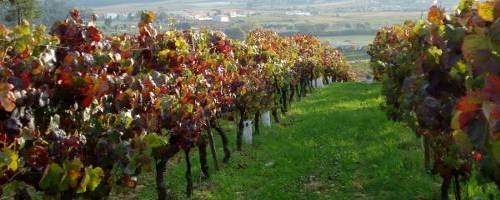
Luis Pato vineyard in Bairrada
Portugal is knocking.
I suggest we answer.
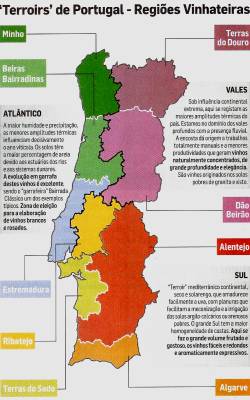
Douro and Port are familiar in our wine vocabulary – for good reason - but what
about the rest of Portugal? What of Bairrada and Dão, Estremadura and Alentejo,
Algarve and Ribatejo? Diverse and distinctive each, but well-known wine
journalist, author and enologist Anibal Coutinho advocates placing these
Portuguese regions into three unique categories; the Valleys, the Atlantic and
the South. His conviction is based upon similarities in terroir. Coutinho is
Portuguese; he knows the wines of Portugal intimately and is a consummate
supporter of them. He has been writing books and reviewing Portuguese wines for
the past four years – handy guides to the best wines and value wines in
Portugal, he also makes wine and writes weekly columns. I joined Coutinho and a
group of international journalists, after my tour of Bairas and Estremadura, in
the small, historic city of Beja, in Alentejo. With Beja as our base, we toured
more wineries and participated in the annual wine festival
Coutinho's map showing
Atlantic, Valley & South
ViniPax – Wine and Sensations from the south of Portugal. Coutinho is an
integral part of ViniPax and is nurturing it into a larger event each year. The
name ViniPax is a blend of Vini (wine) and Pax Giulia which is the historic
Roman name of Beja.
Although still in its infant stages (next year will be its third) ViniPax could
some day prove to be one of the most important wine events of the Iberian
Peninsula.
(more on ViniPax
and Alentejo coming soon)
What does Portugal have to
offer besides Port? Where do I begin? Perhaps in the Atlantic regions, in the
north, in Minho with Vinho Verde’s crisp white, spritzy, food friendly wines or
in the north-central Atlantic Bairrada (within Beiras) with the indigenous red
varietal Baga or the whites Bical or Fernão Pires. Below Bairrada, another
special region along Atlantic Portugal, Estremadura, encompasses Lisbon and has
now officially changed its regional name to Lisboa. In Estremadura I loved the
fresh, floral white Arinto wines. Of course there is also the valley region of
Dão (another important DOC of Beiras), a large chunk of terroir below the famed
Douro Valley. Douro, where traditional varietals like Touriga Nacional, Tinta
Roriz (aka Aragones), Tinta Franca, Tinta Barocca, Sousão and Tinta Cão are made
into luscious table wines and the celebrated fortified Port wines. Then there's
the warm south with Ribatejo (soon to be merely Tejo) in central Portugal just
east of Estremadura, or the arid flatlands of Alentejo where the stunning white
Antão Vaz is stealing the show and Alicante Bouchet holds great promise side by
side with Trincadeira, Aragones and Castelão.
Along the bottom of Portugal is the Southern region of Algarve and rolling
around the south-Atlantic coast is Terras do Sado - both of which are immerging
wine regions. I could start anywhere but I will take you on the same route I
took after landing in the dramatic, ancient city of Lisboa.
I promise you now – the
varietal names are confusing but I guarantee you’ll
appreciate them all.
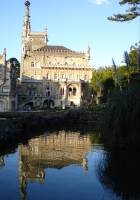
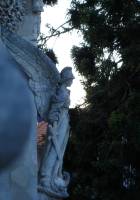
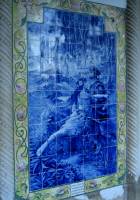
Palace Hotel Busaço and Convent above Luso in Bairrada, stunning
Azulejos (hand painted tiles)
Beiras - Atlantic and Valley Region
Within the broad
boundaries of Beiras, which flows from the Atlantic and stretches across
Portugal to the Spanish border in the east are the DOCs of; Bairrada, Dão, Beira
Interior and Távora-Varosa.
In the DOC Barraida, the indigenous tough, tannic red grape Baga and the whites
Bical, Maria Gomes (aka Fernão Pires) and Siria (aka Roupeiro) shine. I stayed
at the Gothic Busaço (Bussaco) Palace on the forested hilltop above the town of
Luso. The protected Busaço Forest rises above Luso, which is known for its
drinking water and for healing, therapeutic spas. It is also nearby, in Mealhada
where eating suckling pig is not just the mainstay, it’s the culture. The high
acidity Baga as well as the crisp Bical, and Fernão Pires grapes in still or
sparkling (espumante) cut through the fattiness of the young meat which is
purchased from favoured caterers and restaurants in the area. But the cheeses
from around Beiras are also delicious with the wines. Queijo da Estrela, a
gooey, flavourful sheeps milk cheese was a particular favorite of mine.
East of Bairrada, in the much larger DOC Dão the prominent red varieties are
Touriga Nacional, Tinta Roriz (aka Tempranillo in Spain, aka Arogonez in
Portugal) and Alfrocheiro . And the favoured whites are Bical and Encruzado.
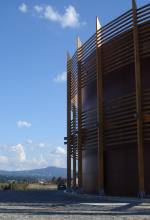
Quinta do Encontro
Our first stop was nearby in S. Lourenço do Barrio, where the new 35 hectare Dão
Sul property of Quinta do Encontro dominates a hilltop over the area. Built to
resemble an oak barrel with staves, this round winery draws together elements
reminiscent of corkscrews and bottle necks in every aspect. Dão Sul also has
properties in the Dão, Duoro, Alentejo, Estramadura and even one in Brazil but
in order to save time we tasted as many wines as we could from each property
without leaving the contemporary comfort of Quinta do Encontro.
Quinta do Encontro Bical,
Bairrada, 2007 –
super fresh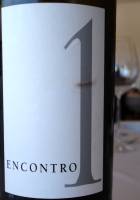 and creamy aromas minerals and honeycomb, peach skins and white floral notes.
The palate echoes the aromas – both creamy and crisp with lime juiciness and a
mouth-watering finish. Fresh and easy.
and creamy aromas minerals and honeycomb, peach skins and white floral notes.
The palate echoes the aromas – both creamy and crisp with lime juiciness and a
mouth-watering finish. Fresh and easy.
Quinta do Encontro ‘Encontro
1’, Bairrada, 2007
is the top white for QdoE on this property. It’s a 50/50 blend of Bical and
Arinto (Arinto appears throughout Portugal). Tropical fruit notes – pineapple
and melon – honeysuckle and spice. The flavours echo the aromas, the palate is
rich and buttery. A great balance of richness and freshness from six months of
lees battonage and barrique ageing.
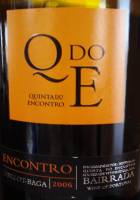
Quinta do Encontro Encontro
Merlot~Baga, Bairrada 2007 is Encontro’s easy-to-drink red made with a higher percentage of Baga.
It has aromas of saddle leather and plums, black current and farmyard hints with
fresh cracked pepper. On the palate – plush fruit, peppery spices with good
acidity.
Quinta de Cabriz Encruzado Dão,
2007 – The indigenous white varietal called Encruzado has creamy honey
and bright
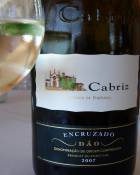 fruity
– melon and citrus – as well as floral aromas. Softly oaked with a creamy
character due to lees battonage and oak barriques the palate is fresh yet
slightly toasty and nutty, the acidity s rounded and the finish spiced.
fruity
– melon and citrus – as well as floral aromas. Softly oaked with a creamy
character due to lees battonage and oak barriques the palate is fresh yet
slightly toasty and nutty, the acidity s rounded and the finish spiced.
Quinta de Cabriz Reserva Dão,
2005 uses a base blend of Touriga Nacional, Tinta Roriz and Alfrocheiro.
The aromas are sweet and chocolaty, with allspice, ripe berries and cherries
followed by rustic earthy/leathery undertones. Supple on the entry featuring
ripe, extracted fruit, the mid-palate grows more powerful and the texture become
a bit dusty and spicy, the finish shows fine, lingering tannins.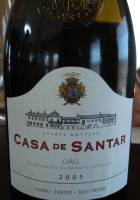
Sociedade Agricola De Santar
S.A ‘Conde de Sabugal’ Douro, 2007
is made from 100% Muscatel. It has a lovely peachy tint with pretty floral,
honey, grapey and peachy aromas, minerals and musky undertones. The palate shows
creamy fruits with a hint of spice and zest, a zippy finish with a
not-unpleasant bitter finale.
Sociedade Agricola De Santar
S.A ‘Casa de Santar’ Dão, 2005 is the most traditional of the Dão Sul properties. The base blend in
Touriga Nacional, Tinta Roriz and Alfrocheiro and the aromas are dark and earthy
– dark berries,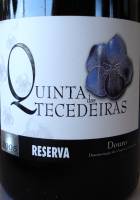 peppercorns, a hint of green vegetal, dark floral, sweet cocoa and toasty hints
of the back end. Silky on the palate, elegant and fresh with dense, liqueur-like
flavours and finely ground pepper lingering on the finish.
peppercorns, a hint of green vegetal, dark floral, sweet cocoa and toasty hints
of the back end. Silky on the palate, elegant and fresh with dense, liqueur-like
flavours and finely ground pepper lingering on the finish.
Quinta des Tecedeiras Reserve,
Douro, 2005
is a gorgeous wine with sweet ripe briary berry aromas, mint chocolate and
allspice. It’s intense and rich on the palate with espresso, chocolate, camphor
and spice. It’s both powerful and opulent with ripe tannins that fasten to your
palate. Oddly enough I tasted this wine paired with eggs and spinach (something
that you would never assume would work) and it did – very nicely.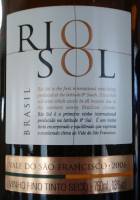
ViniBrasil ‘Rio Sol’,Vale do
São Francisco Brazil, 2006
is a blend of Cabernet and Syrah. The Vinibrasil property is 200 hectares in the
hot northern Vale do São Francisco. In fact, because the year round heat (the
vineyards here are between 9˚ – 10˚ Southern Latitude), the vines are harvested
twice a year shortening their life span and therefore the need to replant more
often. But this wine shows off with fresh, ripe berry aromas, unique toffee and
candied nuts and velvety chocolate. Opulent on the palate, spiced, sweet
berries, balanced old world tannins and acidity with new world fruit expression.
Dense, quite powerful and delicious Rio Sol is just being released to the world.
Quinta des Tecedeiras LBV Port,
Douro 2001 of course
a meal with a wine from Douro would not be complete without tasting a Port. This
particular fortified wine spent four years in a stainless steel tank then two
years in barrel before being bottle in 2007. It was highlighted by sweet dried
fruits and spice aromas. Liqueur-like intensity with lovely brightness, dried
fruits and pepper on the palate – thick, warm and sweet, it paired well with a
crème brûlée topped with heaps (honestly) of cinnamon.
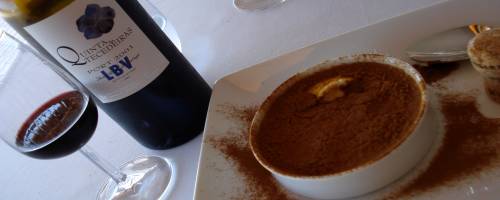
crème brûlée topped with heaps of cinnamon paired with LBV Quinta
des Tecedeiras Port
Aliança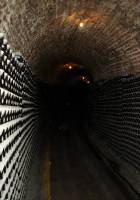
Down the road from
Luso is Aliança, which
up until recently was known as Caves Aliança. It had been a family winery since
1927 but was bought by the company Bacalhoa in 2007. They make espumante
(sparkling wines), still wines and brandy. Their impressive cellars in Bairrada
(circa 1923) hold millions of these bottles and barrels as well as three
bottling lines in the winery above. They bottle approximately 104,000 bottles of
sparkling wine each month and they have vineyards under different quintas and
labels in the Douro, the Dão, Bairrada, Alentejo and Beiras. The winery here
also has an amazing 7000 capacity barrel cellar full of Brandy aged for seven to
forty years.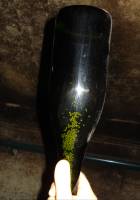
Aliança Bairrada White, Bairrada, 2007 is a blend of two local varieties
Bical and Maria Gomes (aka Fernão Pires) with bright floral and mixed tropical
and orchard fruit aromas. The palate shows juicy lime and pear, spice and citrus
zest – the acidity is softly rounded. Fresh.
Aliança Bairrada Reserva Red,
Bairrada, 2006 is a
blend of Jaen, Touriga Nacional and Tinta Roriz with dark floral and rich dark
fruit aromas with a hint of chocolate shavings. Its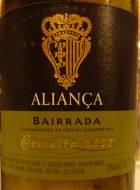 ripe and rounded on the palate with good power, solid fruit, coffee ground and
toasted oak flavours followed by polished tannins.
ripe and rounded on the palate with good power, solid fruit, coffee ground and
toasted oak flavours followed by polished tannins.
Aliança Rose Bruto, NV
is a blend of Baga and
Touriga Nacional. It has lovely peach skin and smooth berries; it’s off dry and
bright with a creamy mousse and firm structure. It pairs very well with salted,
roasted nuts.
Quinta da Terrugem Red,
Alentejo, 2006 shows
dense,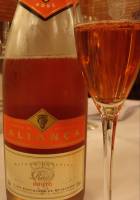 ripe fruit on the nose with a lush palate of cassis and
blueberry, spice, vanilla, cloves and black pepper on the finish. The finish is
supple and made for the consumer palate. A blend of the Tinta Roriz and the
popular Alentejo grape variety Alicante Bouschet.
ripe fruit on the nose with a lush palate of cassis and
blueberry, spice, vanilla, cloves and black pepper on the finish. The finish is
supple and made for the consumer palate. A blend of the Tinta Roriz and the
popular Alentejo grape variety Alicante Bouschet.
Quinta Dos Quatro Ventos Douro
Reserva Red, Douro 2006 is a blend of Touriga Nacional and Tinta Roriz. The aromas are lovely
and bright - dark flowers, mixed berries, iodine, cedar and spice. Supple on the
palate – fresh creamy
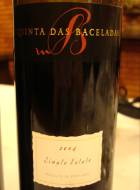 fruit strokes your tongue followed by mocha and pepper – harnessed power
with impressive elegance.
fruit strokes your tongue followed by mocha and pepper – harnessed power
with impressive elegance.
Quinta das Baçeladas Red,
Bairrada, 2004 is an
earthy Cabernet Merlot blend with mixed currents, graphite and gravel aromas.
Velvety and ripe on the palate with loads of juicy fruit and peppery spices and
finally polished tannins on the finish
Vista TR Vinho Regional Red, Beiras, 2005 – The TR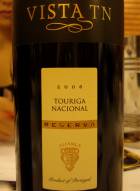 stands for Tinta Roriz of which comprises 90% of this
wine (the rest is Touriga Nacional). The 2006 was a bit closed on the nose but
it gave up some red fruit and chocolate notes.
stands for Tinta Roriz of which comprises 90% of this
wine (the rest is Touriga Nacional). The 2006 was a bit closed on the nose but
it gave up some red fruit and chocolate notes.
The palate is smooth and juicy with berries and some dusty, earthy textures. The
tannins are fine but drying. The TR is available in BC - to read my review for
the most recent vintage 2004 click here.
Vista TN Vinho Regional Reserva Red, Beiras, 2006 like the TR spells it out
for you. This wine is made from Touriga Nacional from around Beiras (which means
it does not fall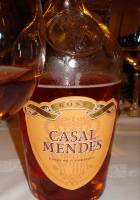 into the DOC of Bairrada). Its sweet vibrant berry aromas are more obvious than
the TR and its palate it powerful and masculine (typical Touriga Nacional) with
grapey purple fruit
flavours supported by char and coffee - the tannins are ripe but grippy.
into the DOC of Bairrada). Its sweet vibrant berry aromas are more obvious than
the TR and its palate it powerful and masculine (typical Touriga Nacional) with
grapey purple fruit
flavours supported by char and coffee - the tannins are ripe but grippy.
Available in some regions in Canada – represented by PMA
And just for fun
Casal Mendes Rose Espumante, NV this coral pink sparkling spells fun –
it’s sweet and juicy with candy floss, banana and strawberry aromas. It has good
acidity which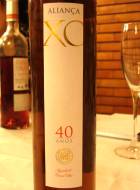 offsets some of the sweetness and tastes of berries and candied citrus zest.
Made from Baga.
offsets some of the sweetness and tastes of berries and candied citrus zest.
Made from Baga.
for more information on Alianca
click here
Independent Wine Growers Association
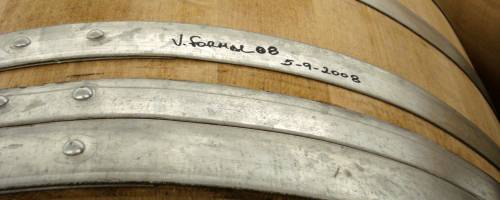
barrel in
in the Luis Pato cellar
Our next stop was at the
modern, art gallery styled winery of Luis Pato on the Quinta do Ribeirnho in
Amoreira da Gândara on the western border of Bairrada. Pato is a compact, droll,
mustached man who has a passion for the Bairrada grape – Baga. The Pato winery
was to be our meeting point for four of the six members of the Independent
Winegrowers Association. The IWA came to fruition only a few years ago,
developed in hopes of promoting their products (locally and internationally)
more effectively. The members hail from different regions and produce more than
50 different styles of wine as a whole. All produce estate grown wines which
they bring together regularly for events and tastings. The IWA includes Casa de
Cello, Domingos Alves de Sousa, Luis Pato, Quinta do Ameal, Quinta de Covela and
Quinta dos Roques.
The reviews from these producers follow below.
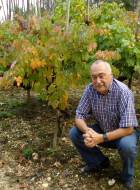
Luis Pato IWA
In Portuguese, Pato
means ‘duck’ and is pronounced more pat... with a soft drag on the ‘o’
rather than Pat-O. Pato’s daughter Filipa is also a winemaker and has quite a
name for herself not only in blending wines but in molecular winemaking by using
cryoextraction. To make her and her fathers dessert wine FLP she freezes the
grapes and used the cryoextraction to remove water from the grapes thereby
intensifying the juice (like icewine).
Luis Pato in his 80 yr old Barossa Baga vineyard
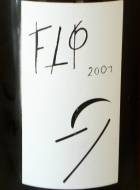 The
FLP (Filipa and Luis Pato) is a blend of Bical
(50%), and equal parts
of Cercial and Sercialinho (a cross between Cercial and Alvarinho). Its fresh,
low alcohol, not too sweet with good acidity and a creamy texture. Only 3000
bottles for export only.
The
FLP (Filipa and Luis Pato) is a blend of Bical
(50%), and equal parts
of Cercial and Sercialinho (a cross between Cercial and Alvarinho). Its fresh,
low alcohol, not too sweet with good acidity and a creamy texture. Only 3000
bottles for export only.
Luis Pato Vinhas Velhas White
Wine, Bairadda, 2007
is a blend of Bical, Cercial and Sercialinho made in 50% second use oak and the
rest in stainless steel. It is fresh but creamy with tropical fruit, minerals,
citrus and spice. Rounded on the palate but showing nice acidity. A good partner
to fish and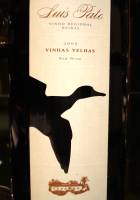 cheeses.
cheeses.
Luis Pato Vinha Formal White
Wine, 2000 is an
aged Bical that was fermented and aged in new Allier French oak. The aromas bear
striking similarities to an aged Riesling – lime zest, honey and petrol with
savoury-mushroomy characteristics and a hint of vanilla. The flavours are
savoury and foxy as well with wild honeycomb and aged mushroomy tones. An
interesting wine, more traditional than modern in style.
A trio of bubbly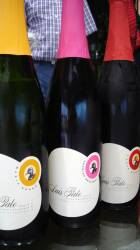
Luis Pato Espumante
Maria Gomes is a
very refreshing sparkling white – very pretty with floral and tree fruits and a
fresh moussy palate.
Luis Pato Espumante Touriga Nacional is pretty in pink with aromas of
berries in cream and spices. Good Touriga Nacional typicity but in a refreshing
sparkling package with a full moussy palate that will pair with roasted meats,
vegetables or perhaps chocolate…
Luis Pato Espumante Baga has a bit more sweetness than the Touriga
Nacional and is very intriguing. Tobacco, earth and cherries, a full moussy
texture and clean finish. Perfect paired with the local delicacy of suckling pig
but would also be good with Christmas turkey, ham or dense, oily fish.
The Luis Pato
Espumante Maria Gomes and Espumante Baga have both just arrived in BC. Look for
them in private wine stores for about $20-$25.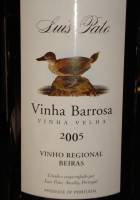
Luis Pato Vinhas Velhas
Barossa, Beiras, 2005
is Pato’s top wine made from an 80 year old vineyard called Barossa. There was
no 2006 nor was there a 2007 made but the 2008 was in barrel. The aromas are
fresh berries and pine/eucalypt notes. The mixed and pine reappears on the
palate with pepper and spiced chocolate, its direct and concentrated on the
entry and with time the mid palate will round out and the powerful grip of
tannin will ease. Pato recommends drinking this wine between 8-15 years when the
tannin sweetens.
For more information on Luis Pato click
here
Casa do Cello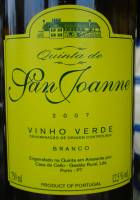 IWA
IWA
Patricia Magalthães, the soft
spoken enologist (the second female enologist I met that day) from Casa de Cello
arrived with red wines from Casa do Cello's Dão estate of Quinta da Vegia and
whites from their northern Minho estate of Quinta de SanJoanne. Four generations
have contributed to Casa de Cello which is now overseen by João
Pedro Araujo. Casa de
Cello is 14 hectares located very near Amarante in Minho where they produce
still and sparkling Vinho Verdes as well as Vinho Regional Minho wines.
Quinta de San Joanne White,
Vinho Verde, 2007 is
a blend of two grapes, Avesso (gives structure) and Loureiro (aromatics).
Typical, bright, clean aromas – green apple,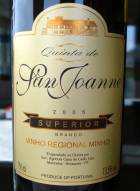 citrus and minerals. Light and fresh in the mouth with a tart, crisp finish.
Perfect with white fish.
citrus and minerals. Light and fresh in the mouth with a tart, crisp finish.
Perfect with white fish.
Quinta de San Joanne White, Superior, Minho 2005 combines Alvarinho and
Malvasia Fina to make this richly aromatic wine – vibrant citrus, honeysuckle,
peach skin, petrol, minerals and honeycomb – reminiscent of Riesling. The palate
features round acidity on the entry, crisp flavours and a snappy finish.
Porta Fronha Red, Dão, 2006 is a blend of Tinta Roriz and Touriga
Nacional with black cherry and dark floral aromas with earthy notes and wild
berries.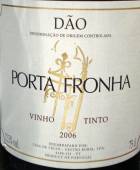 Sweet
spiced and earthy
Sweet
spiced and earthy
on the palate, cocoa beans and tobacco. Smooth and dry with a rustic tilt and
good acidity with fine, drying tannins on the finish.
Quinta de Vegia Red Reserva,
2005 is made from
Touriga Nacional and Tinta Roriz and has primary purple fruit aromas -
blackberry and blueberry with sweet cedar and tobacco. Rich and supple with ripe
berries and chocolate on the entry followed by a dense, plummy finish with ripe
tannins.
For more information on Casa do Cello
click here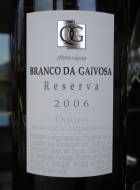
Alves de Sousa IWA
The Alves de Sousa
family has been making wine and growing grapes in the Douro for generations.
Like many, the grapes and wine were sold to major Port houses. Now produced
under their own label Alves de Sousa. I thought these wines were superb,
powerful and ripe – structured wines that North American consumers will love.
Their estate in the Douro is called Quinta da Gaviosa – the wines are made by
Domingos Alves de Sousa and now his son Tiego. Tiego, a handsome, soft spoken
young man joined us as we tasted through the IWA wines, his dedication to his
family business and winemaking was evident not only in his purple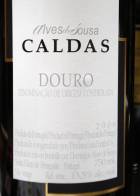
stained hands but in his words.
Alves de Sousa Branco da
Gaviosa Reserva, Douro,
2006 is an aromatic white (branco) blend of Malvasia Fina, Gouveio and
Arinto. Ripe tree fruit aromas, exotic flora, minerals and honey notes with
wonderfully integrated oak components. Despite seeing close to a year in new
French oak the fruit shines on palate and nose, its smooth and lush with a
spiced/buttery finish.
Alves de Sousa ‘Caldas’, Douro,
2006 is an
entry-level blend of Tinta Baroca and Touriga Nacional a rustic mixture of
leather, mixed berry and cherry with peppery spices.
There are powerful tannins on this youngster but it also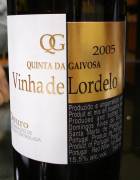
shows good acidity and fresh spiced fruit.
SAQ for $14.85
Alves de Sousa ‘Caldas
Reserve’,Douro, 2005
is primarily Tinta Roriz and has a bright ruby-purple hue and juicy fruit aromas
of cherry and blueberry. The palate is sweet, concentrated and supple with lush
fruit and wood spice flavours.
Alves de Sousa Quinta da
Gaviosa ‘Vinha de Lordelo’ Douro, 2005 is from a 90+ year old vineyard and is a field blend of
Sousão, Tinta Amarela, Touriga Nacional and
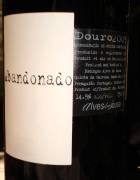
most likely ‘others’. It has bright, exotic aromas of red fruits, coffee and
iodine, sweet cedar, tobacco and minerals. Super ripe and smooth on the palate,
concentrated fruits and vanilla with an excellent, lingering spiced finish.
The Alves de Sousa ‘Abandonado’ Douro, 2005 hails from 80+ year old
vineyards and is a field blend of Tinta Amarela, Touriga Franca, Tinta Roriz and
others… It also spent 12 months in new Portuguese oak (something I noticed was
being used sporadically around Portugal). Dense in colour with aromas of
sun-warmed berry aromas – blueberry and blackberry – tar and meaty, charred
notes, sweet spices and purple flowers. Decadent, concentrated ripe fruit and
chocolate
with toasty/char flavours on the finish.
An excellent wine – in need of decanting.
The Alves de Sousa wines are recurrently represented in the SAQ
stores.
I have word that BC and Alberta may be receiving some in spring 2009.
For more information on Alves
de Sousa click here
Quinta dos Roques IWA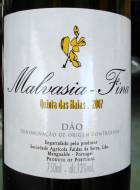
Quinta dos Roques is located in the hamlet of Abrunhosa dos Roques in the Dão
DOC. Luis Lourenço was a teacher of math before becoming a winemaker – in both
you have to know your numbers. His voice projects like a man who is used to
having to talk over others – perhaps from his years of teaching or perhaps to be
heard by his in-laws, the Roques de Oliveira family who planted their new
vineyards in the 1980s. Choosing traditional red varieties such as Touriga
Nacional, Jaen, Alfrocheiro and Tinta Roriz and whites like Encruzado, Malvasia
Fina, Bical and Cercial the family sold their grapes to the co-op. It was under
the influence of Luis they decided to build a modern winery which was so
successful that they purchased a second estate named
Quinta das Maias.
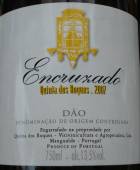
The Quinta das Maias Malvasia Finca, Dão, 2007 has very pretty floral
aromas, honey and pear-apple. Clean and fresh on the plate – rounded with honey
tones and crisp fruits. Easy drinking wine that will pair well with fresh
cheeses and light starters.
Quinta dos Roques Encruzado,
Dão, 2007 is a
combination of honeysuckle, ripe tree fruits, minerals, oak vanillin and honey.
Creamy and slightly buttery on the palate it’s nonetheless fresh. Zippy citrus
and bright fruit with spice,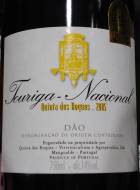
rounded acidity and a clean finish.
$22.60 SAQ 2005 vintage
Quinta dos Roques Touriga
Nacional, Dão, 2005
is filled with lush fruit aromas, purple flowers, sweet tobacco and iodine with
some minty notes. Supple and ripe on the palate – purple berries, vanilla and
sweet cocoa. A very nice wine.
$30.25 SAQ 2003
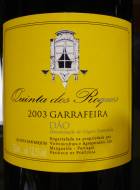 Quinta
dos Roques ‘GarraFiera’ Grand Reserve, Dão, 2003
has bright cherry and plush berry aromas, iodine mint and loads of
fragrant floral notes with sweet cedar and vanilla. Ripe, creamy berry fruit,
chocolate and spice flavours with a silky texture, fine tannins, bright acidity
and a delicious lingering finish. A blend of Touriga Nacional, Alfrocheiro,
Tinta Roriz and Tinta Cão
Quinta
dos Roques ‘GarraFiera’ Grand Reserve, Dão, 2003
has bright cherry and plush berry aromas, iodine mint and loads of
fragrant floral notes with sweet cedar and vanilla. Ripe, creamy berry fruit,
chocolate and spice flavours with a silky texture, fine tannins, bright acidity
and a delicious lingering finish. A blend of Touriga Nacional, Alfrocheiro,
Tinta Roriz and Tinta Cão
$33 SAQ 2003 vintage
Some of the
Quinta dos Roques wines may be available in Ontario.
For more information on Quinta dos Roques
click here
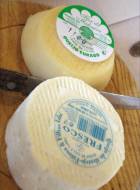
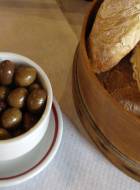
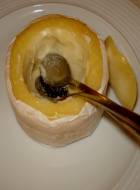
fresh cheese lands on your table as soon as you sit at
Adega Vila Verde with local olives and Portuguese bread,
and soft sheeps milk cheese called Queijos de Azeitão
in Terras do Sado
Lisboa (formerly Estremadura) - Atlantic Region
Lisboa is a long narrow region
which rolls along the Atlantic coastline from Lisbon, encompassing Leira until
it butts up against Beiras. The DOCs are; Carcavelos in the southernmost corner,
Colares seaside, upward it's Bucelas, Alenquer on the eastern-central Lisboa
border, Torres Vedras to its west, Lourinhã and Óbidos mid region and finally
Encostasde Aire. Lisboa (Estremadura) falls into Anibal Coutinho’s “Atlantic
Region” philosophy. Here white grapes like Arinto, Fernão Pires (aka Maria
Gomes) and Alicante Branco succeed in the milder maritime climate and reds like
Castelão (aka Periquita) as well as a little Trincadera (especially toward
Lisboa’s neighbor Ribatejo). Here the food focus is fish – close to the ocean of
course – sardines, sea bass and eels, fish stew and deep fried foods and
something I saw very frequently in winery restaurants and in small local tascas
(eating place) duck in rice (arroz de pato). All good with fresh wines with
bright acidity…
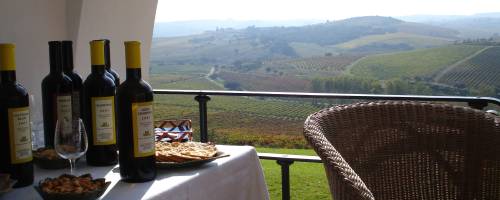
view of the vineyards from Quinta da Boavista
Casa Santos Lima
Casa Santos Lima is a mere 45 minutes drive from Lisboa (depending on the
traffic) in the DOC Alenquer. It is a large family owned company that owns seven
neighboring quintas (estates) covering just under 300 hectares – 200 of those
are under vine. I visited the stunning Quinta da Boavista (beautiful view -
which it truly) where the 3 million bottles of Santos Lima wines are produced
annually. I tasted an amazing collection of 30 (out of a total 43) wines here –
made with 30 different traditional and non-traditional varietals geared toward
the export market.
A few of those I tasted
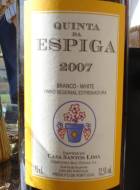
Casa Santos Lima Quinta da Espiga, Estremadura, 2007 is a crisp blend of
the white varieties of Fernão Pires, Vital, Arinto, Moscatel and Sauvignon
Blanc. Aromas are spring blossoms, honey and pear/apple fruit. It’s smooth and
fresh with creamy orchard fruits and rounded acidity. Very easy drinking.
BC private wine stores about $15
Casa Santos Lima Palha~Canas,
Estremadura, 2007 blends Fernão Pires, Arinto, Chardonnay and Vital has clean mineral and citrus
with honey and floral notes. It’s crisp and fresh with primary mineral and
citrus flavours reflecting the
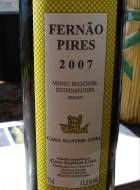
chalky soil the grapes are grown in. Good food wine – fish, salads and soft
cheeses.
Casa Santos Lima Fernão Pires,
Estremadura, 2007 is
one hundred percent varietal and is crisp, straight forward white fruit aromas
with citrus and minerals. It has a silky entry with a clean, softly rounded
palate. Very fresh.
Casa Santos Lima ‘Eximus’,
Estremadura, 2007 is
a young wine but very easy drinking with sweet ripe berry fruits, leather and
loads of peppery spices. Medium-bodied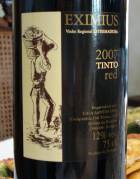 and quite bright on the palate it lingers with smoked spices. A good flavour
profile made from a blend of Castelão, Tinta Miúda, Camarate and Cabernet
Sauvignon.
and quite bright on the palate it lingers with smoked spices. A good flavour
profile made from a blend of Castelão, Tinta Miúda, Camarate and Cabernet
Sauvignon.
Casa Santos Lima Quinta das
Setencostas, Alenquer DOC, 2006 stands out with its rich aromas – jammy mixed berry fruit,
exotic spices and vanilla. Creamy fruit on the palate, round and spiced with
lovely structure and a peppery finish. Balanced, medium-full bodied with a
polished finish. Castelão, Camarate, Tinta Miúda and Preto Martinho.
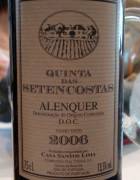
Casa Santos Lima Castelão,
Estremadura, 2007
shows loads of summer berries – blueberry, raspberry and blackberry, vanilla and
allspice with minty nuances – a very quaffable wine.
Casa Santos Lima Alfrocheiro,
Estremadura, 2005
has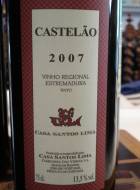 creamy aromas – field berries, vanilla and sweet spices. The palate is more
reserved than the nose with red fruits, spice
and minerality. It shows good acidity and is medium-bodied
creamy aromas – field berries, vanilla and sweet spices. The palate is more
reserved than the nose with red fruits, spice
and minerality. It shows good acidity and is medium-bodied
making it a good food wine with grilled sardines, pork or duck.
BC private wine stores about $22+
Casa Santos Lima Sousão,
Estremadura, 2006 is
a very extracted colour with intense aromas of black fruits and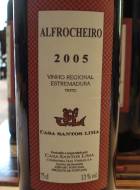 chocolate with chalky minerality. The flavours are dried fruits
and spice with a peppery
finish. Seems quite hot on the
chocolate with chalky minerality. The flavours are dried fruits
and spice with a peppery
finish. Seems quite hot on the
palate compared to some of the other reds – at 14% alcohol.
BC private wine stores about $24+
Casa Santos Lima ‘Touriz’,
Estremadura, 2006 blends Touriga Nacional, Touriga Franca and Tinta Roriz to
make this appealing red. It features ripe red berry and cherry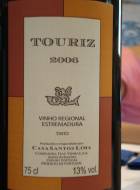 aromas with earthy, dark undertones and spice and vanilla. It is silky and ripe
on the palate – layers of fruit, leather, tobacco and spice that lingers on the
finish.
aromas with earthy, dark undertones and spice and vanilla. It is silky and ripe
on the palate – layers of fruit, leather, tobacco and spice that lingers on the
finish.
Some of the Casa Santos Lima wines are available in several
regions across Canada including Quebec, Ontario and British Columbia
For more information on Casa
Santos Lima click here
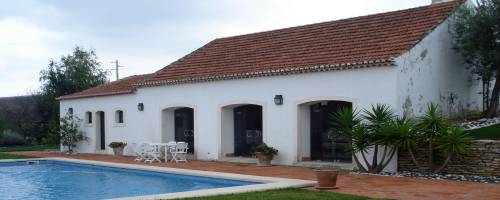
Quinta de Chocapalha
Quinta de Chocapalha

Quinta de Chocapalha is situated near Casa Santos Lima in Alenquer. But in
contrast, Chocapalha is a small hands-on family winery with limited production.
Alice and Paulo Tavares da Silva purchased this estate in the 1980s from the
Duff family – decendants of a Scottish aristocrat named Diogo Duff who received
it in the 1800s. Paulo, a very tall, retired Portuguese naval officer and his
chic Swiss-born wife Alice live at the estate near Aldeia Galega where they
oversee daily operations. Their on-site winemaker Diego Sepulveda is managed by
their daughter Sandra Tavares da Silva who is a recognized winemaker at Quinta
Vale Dona Maria in Douro and the only female winemaker included in the “Douro
Boys”. Sandra’s husband Jorge Serodio Borges is also a winemaker in the Douro.
Alice Tavares da Silva
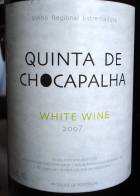
Quinta de Chocopalha Fernão Pires, Estremadura, 2007 has fresh
citrus and mineral aromas, lime zest and riper white fruits. Zippy and clean on
the palate with an almost oily texture and mouth-watering finish.
Quinta de Chocoapalha White,
Estremadura, 2007 is
a blend of Arinto, Voisinho and Vital with lovely creamy honey, apple blossoms
and orchard fruit aromas. Fresh with bright fruit, mineral and honey flavours
and snappy acidity.
Quinta de Chocoapalha Vinha da
Palha Rose,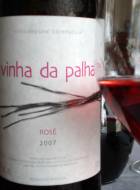 Estremadura Rosé, 2007 is made with Touriga Nacional and Tinta Roriz. It has an
appealing fragrance of strawberries and spices and flavours of mixed summer
berries, tobacco, citrus and spices. Crisp and dry – a consummate food wine to
be paired with anything from seafood and salads to cheese and white meats.
Estremadura Rosé, 2007 is made with Touriga Nacional and Tinta Roriz. It has an
appealing fragrance of strawberries and spices and flavours of mixed summer
berries, tobacco, citrus and spices. Crisp and dry – a consummate food wine to
be paired with anything from seafood and salads to cheese and white meats.
Quinta de Chocoapalha Red,
Estremadura, 2006
blends 40% Tinta Roriz with Castelão, Touriga Nacional, Syrah and Alicante
Bouschet. Very ripe black fruit – plums and berries – with sweet spices and
violet undertones. Fleshy and rounded on the palate – smooth and elegant with
dark,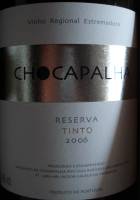 earthy and peppery flavours with some savoury notes and powerful, roasted coffee
bean flavours on the finish.
earthy and peppery flavours with some savoury notes and powerful, roasted coffee
bean flavours on the finish.
Liberty Wine
Merchants BC about $25
Quinta de Chocoapalha Reserva Red, Estremadura, 2006 is very fragrant
with floral aromas, ripe black fruit and juicy purple berries. Luscious and
silky on the palate with chocolate, vanilla, tobacco, violets and cedar box
spices. Power meets elegance with ripe tannins and a drying finish. Very, very
good.
Liberty Wine Merchants BC about $45
For more information on Quinta
de Chocoapalha
click here
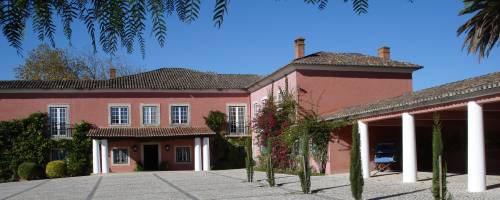
Quinta da Romerio
Quinta da Romerio
Quinta da Romeiro is in the DOC Bucelas in Lisboa (Estremadura). It’s one of
seven quintas owned by Companhia das Quintas which is one of the largest
Portuguese wine and spirits companies. It is a lovely historic estate with pink
stucco buildings said to have been built as a royal house in 1703. In fact the
Duke of Wellington stayed here and used it as a base during the Peninsular War
campaign. The bottling from all seven estates is done here on this 80 planted
hectare estate. Companhia das Quintas is able to focus on the strengths of each
region and each quinta and diversify their portfolio by playing upon these
strengths. The quintas are spread around in; Alentejo, Beiras Interior, Bairrada,
Douro, Terres do Sado and Estremadura. Here in Bucelas Arinto is the queen –
where the milder climate (due to its valley location between to the Atlantic
ocean and the wide Tagus River estuary) allows for slower ripening and high
acidity.
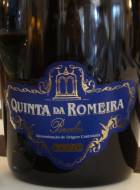
The Quinta da Romeira
Espumante, Bucelas, 2005 may be the most wonderful sparkling (espumante) I
tasted on this trip. Made from 100% Arinto it’s perfumed with apples and citrus
blossoms, peach skin and almonds with ginger and leesy undertones. Complex and
creamy with rich honey and leesy tones, apple and citric flavours, a pleasing
mousse and lingering finish.
Delicious.
Prova Regia Arinto, Bucelas
DOC, 2007 has lovely
vibrant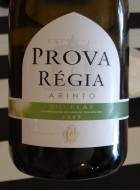 aromas of pomelo and passionfruit underscored by melon. The palate is
surprisingly Sauvignon Blanc-ish with grassy, exotic citrus and mineral
flavours. Its gorgeous on the palate – fresh and yet creamy smooth with an
extended finish. Delicious solo or pair with spinach crepes in cream sauce.
aromas of pomelo and passionfruit underscored by melon. The palate is
surprisingly Sauvignon Blanc-ish with grassy, exotic citrus and mineral
flavours. Its gorgeous on the palate – fresh and yet creamy smooth with an
extended finish. Delicious solo or pair with spinach crepes in cream sauce.
Fronteira, Douro DOC, 2005 is a blend of Touriga Nacional, Touriga Franca and Tinta Roriz. Juicy
and jammy with aromas of blackberry, plums and chocolate. Creamy and rich with
espresso, chocolate and spice flavours with fine tannins on the finish.
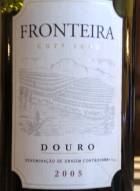
Fronteira Reserva,
Douro DOC, 2005 like
the entry level Fronteira is a blend of Touriga Nacional, Touriga Franca
and Tinta Roriz. Aromas are sweet ripe blueberries, mixed briary berries, purple
flowers and a hint of ginger. Smooth and complex with juicy fruits, coffee and
pepper – it’s supple and concentrated with polished tannins
The Farizoa Selecção do
Enologo Borba Alentejo, 2003 blends Trincadeira, Aragonês, Touriga Nacional
and Alicate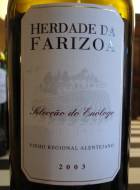 Bouschet into this lovely rich dried fruits and prune aromas, espresso,
blackberries and smoky dark earthy undertones. Juicy on the palate with dried
cherry, fig and smooth spices in a full-bodied traditionally structures and
flavoured wine. Very good.
Bouschet into this lovely rich dried fruits and prune aromas, espresso,
blackberries and smoky dark earthy undertones. Juicy on the palate with dried
cherry, fig and smooth spices in a full-bodied traditionally structures and
flavoured wine. Very good.
The 2004 has sweet smoky summer berry and cherry fruit with warm spices
and coffee on the nose. Rustic aromas, earthy tones, juicy and bright with ripe,
lingering tannins.
Ribatejo - Southern Region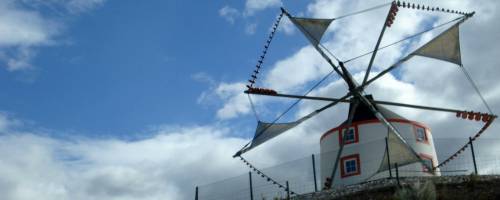
windmill in Estremadura
Although it compares in vineyard size,
Ribatejo has less than half the wine production of neighboring Estremadura. Much
of the production comes from growers who sell to the co-op and therefore there
is more focus on high yields than quality. But there are smaller, more serious
producers in Ribatejo who produce whites like; Fernão Pires, Malvasia, Alicante
Branco and reds like; Trincadeira, Touriga Nacional and Castelão.
There are plans in place to shorten the Ribatejo name to simply "Tejo" - like
the name of the River - by next year.
DFJ Vinhos – The New Portugal
 We
drove to meet José
Neiva Correia at his
family estate Quinta do Porto Franco in Alenquer, Estremadura on a supremely
blustery October day. But the actual DFJ Vinhos headquarters are on the Quinta
da Fonte Bela at an old distillery in Ribatejo. From my previous days experience
I thought Casa Santos Lima produced a lot of wines (about 43) so I was floored
to see the portfolio of DFJ to be swimming somewhere up around the 70 mark. But,
due to time constraints and that fierce headwind blowing across Estremadura I
only had time to taste half of them.
We
drove to meet José
Neiva Correia at his
family estate Quinta do Porto Franco in Alenquer, Estremadura on a supremely
blustery October day. But the actual DFJ Vinhos headquarters are on the Quinta
da Fonte Bela at an old distillery in Ribatejo. From my previous days experience
I thought Casa Santos Lima produced a lot of wines (about 43) so I was floored
to see the portfolio of DFJ to be swimming somewhere up around the 70 mark. But,
due to time constraints and that fierce headwind blowing across Estremadura I
only had time to taste half of them.
DFJ wines hail from vineyards in Estremadura, Ribatejo, Alentejo and Douro and
all fall under the chief winemaking skills of José Neiva Correia. Neiva, who has
been a winemaker for 45 years founded DFJ Vinhos with two other business
partners in 1998 (names beginning with D,F and J), and he also contributes his
winemaking skills at Casa Santos Lima. The wines are made to be accessible
worldwide, and they are. It’s a diverse portfolio with many different labels so
I’ll pick through a few that I particularly liked…
José Neiva Correia
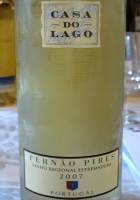
DFJ Monte Alentejano White, Alentejo 2007 is blend of Arinto, Rupeiro (aka
Siria) and Antão Vaz and has bright aromas of orchard and tropical fruit with
floral tones. Its fresh and really zippy on the palate with flavours of tea with
lemon and honey – easy drinking and very interesting.
DFJ Casa Do Lago, Fernão
Pires, Estremadura, 2007 is a very aromatic white with honeysuckle, bright
citric aromas and stone fruits. On the palate there is a hint of grass
clippings, pineapple and melon with crisp apple, citrus and minerals. A wine
that is perfect when its young,
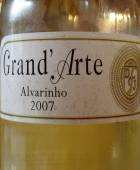
chilled and fresh.
DFJ Alvarinho & Chardonnay,
Estremadura, 2007 is
a 50/50 blend with creamy/buttery notes, melon and pear compote, blossoms and
spice. The texture is smooth, the acidity bright making this a good wine to be
paired with creamy sauces.
DFJ Grand ‘Arte Alvarinho, Estremadura, 2007 has a very pretty bouquet of
peach skin, honey blossoms and minerals.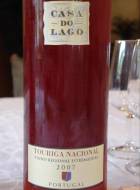 The palate is silky and weighted (different from a Vinho Verde)
The palate is silky and weighted (different from a Vinho Verde)
but with nice acidity and zesty citrus flavours.
$13.95 LCBO
DFJ Casa Do Logo Rosé, Alenquer, Estremadura, 2007 is a pretty
wine made from 100% Touriga Nacional. It’s a softend version of TN though with
summer berry aromas, floral notes and a fresh minerality on the nose and palate.
Delicate in the mouth, dry with flavours of tobacco, berry fruits and citrus.
Very good.
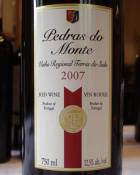
DFJ Pedras do Monte,
Terras do Sado, 2007
is made from Castelão and has a nice old world, new world balance. Aromas of
black cherry, dark berries and cedar with somewhat rustic leathery, spice notes
and vanilla undertones. Fresh fruit on the palate – a hint spritzy - with earthy
flavours, tobacco, cedar and spice. A good everyday drinking or dinner wine.
BC $14 2006 vintage
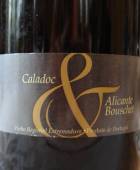 DFJ
Caladoc & Alicante Bouschet, Estremadura, 2007 is a 50/50 blend of Caladoc
and Alicante Bouchet with a dense purple colour. There are loads of savoury
tones here – savoury herbs, bacon fat, and forest floor composty notes with
intense dried fruit armomas. Smoky on the palate, more meaty/bacon fat flavours,
black cherry and dried fruits with a powerful finish and ripe tannins.
DFJ
Caladoc & Alicante Bouschet, Estremadura, 2007 is a 50/50 blend of Caladoc
and Alicante Bouchet with a dense purple colour. There are loads of savoury
tones here – savoury herbs, bacon fat, and forest floor composty notes with
intense dried fruit armomas. Smoky on the palate, more meaty/bacon fat flavours,
black cherry and dried fruits with a powerful finish and ripe tannins.
DFJ Grand ‘Arte Tinta Roriz,
Estremadura, 2005 –
Juicy raspberry and sweet blueberry compote, chocolate, spice and vanilla. Lush
on the palate, wild berry flavours prevail,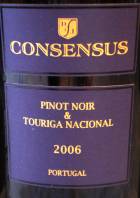 dense but balanced with good acidity and fine grippy tannins on the finish.
dense but balanced with good acidity and fine grippy tannins on the finish.
DFJ ‘Consensus’ Pinot Noir &
Touriga Nacional, Alenquer, Estremadura, 2006 – Similar to the wines at Casa Santos Lima DFJ is
combining local, traditional grape varieties with those that the new world
drinkers recognize – Cabernet, Merlot, Pinot Noir, Syrah - this is in hopes of
introducing international consumers to these traditional varieties by blending
and labeling with varietals they are comfortable with saying and drinking. This
is one of the good ones I tasted with its gobs of sweet berry fruit – blackberry
and wild blueberry – fruitcake spices and vanilla. Plush on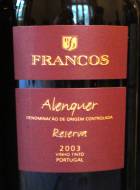 the palate with ripe fruits (bordering on dry fruits)
and spice.
the palate with ripe fruits (bordering on dry fruits)
and spice.
Opulent and structured with powerful, ripe tannins on the finish.
DFJ ‘Francos’ Reserva, Alenquer
DOC Estremadura, 2003
– Sweet aromas of blackberries and raspberries with fleur de sel and meaty notes
with graphite undertones. Smooth on the entry – flavoured with dark fruits,
tobacco, cedar box, pencil shavings, leather and mineral/gravel hints. A blend
of Touriga Nacional, Touriga Franca and Alicante Bouschet.
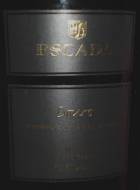 DFJ
‘Escada’ Reserva, Douro DOC, 2005
blends the traditional Douro varietals of Touriga Franca and Tinta Roriz to make
this intense wine. It has creamy aromas – blackberry and black cherry, iodine
and sweet vanillin oak and spice. The fruit is somewhat reserved, the power
comes in the form of minerality, iodine and sweet oak – it needs time to soften
but the structure is certainly there.
DFJ
‘Escada’ Reserva, Douro DOC, 2005
blends the traditional Douro varietals of Touriga Franca and Tinta Roriz to make
this intense wine. It has creamy aromas – blackberry and black cherry, iodine
and sweet vanillin oak and spice. The fruit is somewhat reserved, the power
comes in the form of minerality, iodine and sweet oak – it needs time to soften
but the structure is certainly there.
More of the DFJ wines can be
found in the LCBO
For more information on DFJ Vinhos click
here
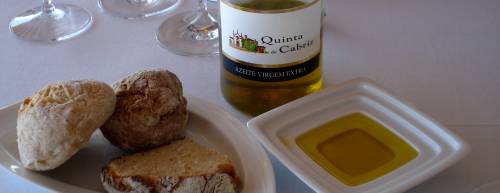
Did I mention the fabulous
bread and olive oil in Portugal...?
Part 2 Portugal is knocking - The South - Alentejo,
Terras do Sado - link here
-end-







 and creamy aromas minerals and honeycomb, peach skins and white floral notes.
The palate echoes the aromas – both creamy and crisp with lime juiciness and a
mouth-watering finish. Fresh and easy.
and creamy aromas minerals and honeycomb, peach skins and white floral notes.
The palate echoes the aromas – both creamy and crisp with lime juiciness and a
mouth-watering finish. Fresh and easy.


 peppercorns, a hint of green vegetal, dark floral, sweet cocoa and toasty hints
of the back end. Silky on the palate, elegant and fresh with dense, liqueur-like
flavours and finely ground pepper lingering on the finish.
peppercorns, a hint of green vegetal, dark floral, sweet cocoa and toasty hints
of the back end. Silky on the palate, elegant and fresh with dense, liqueur-like
flavours and finely ground pepper lingering on the finish.



 ripe and rounded on the palate with good power, solid fruit, coffee ground and
toasted oak flavours followed by polished tannins.
ripe and rounded on the palate with good power, solid fruit, coffee ground and
toasted oak flavours followed by polished tannins.



 offsets some of the sweetness and tastes of berries and candied citrus zest.
Made from Baga.
offsets some of the sweetness and tastes of berries and candied citrus zest.
Made from Baga.


 cheeses.
cheeses.

 IWA
IWA citrus and minerals. Light and fresh in the mouth with a tart, crisp finish.
Perfect with white fish.
citrus and minerals. Light and fresh in the mouth with a tart, crisp finish.
Perfect with white fish. Sweet
spiced and earthy
Sweet
spiced and earthy 













 and quite bright on the palate it lingers with smoked spices. A good flavour
profile made from a blend of Castelão, Tinta Miúda, Camarate and Cabernet
Sauvignon.
and quite bright on the palate it lingers with smoked spices. A good flavour
profile made from a blend of Castelão, Tinta Miúda, Camarate and Cabernet
Sauvignon.


 aromas with earthy, dark undertones and spice and vanilla. It is silky and ripe
on the palate – layers of fruit, leather, tobacco and spice that lingers on the
finish.
aromas with earthy, dark undertones and spice and vanilla. It is silky and ripe
on the palate – layers of fruit, leather, tobacco and spice that lingers on the
finish.


 Estremadura Rosé, 2007
Estremadura Rosé, 2007 earthy and peppery flavours with some savoury notes and powerful, roasted coffee
bean flavours on the finish.
earthy and peppery flavours with some savoury notes and powerful, roasted coffee
bean flavours on the finish.

 aromas of pomelo and passionfruit underscored by melon. The palate is
surprisingly Sauvignon Blanc-ish with grassy, exotic citrus and mineral
flavours. Its gorgeous on the palate – fresh and yet creamy smooth with an
extended finish. Delicious solo or pair with spinach crepes in cream sauce.
aromas of pomelo and passionfruit underscored by melon. The palate is
surprisingly Sauvignon Blanc-ish with grassy, exotic citrus and mineral
flavours. Its gorgeous on the palate – fresh and yet creamy smooth with an
extended finish. Delicious solo or pair with spinach crepes in cream sauce.
 Bouschet into this lovely rich dried fruits and prune aromas, espresso,
blackberries and smoky dark earthy undertones. Juicy on the palate with dried
cherry, fig and smooth spices in a full-bodied traditionally structures and
flavoured wine. Very good.
Bouschet into this lovely rich dried fruits and prune aromas, espresso,
blackberries and smoky dark earthy undertones. Juicy on the palate with dried
cherry, fig and smooth spices in a full-bodied traditionally structures and
flavoured wine. Very good.






 dense but balanced with good acidity and fine grippy tannins on the finish.
dense but balanced with good acidity and fine grippy tannins on the finish.
 DFJ
‘Escada’ Reserva, Douro DOC, 2005
DFJ
‘Escada’ Reserva, Douro DOC, 2005